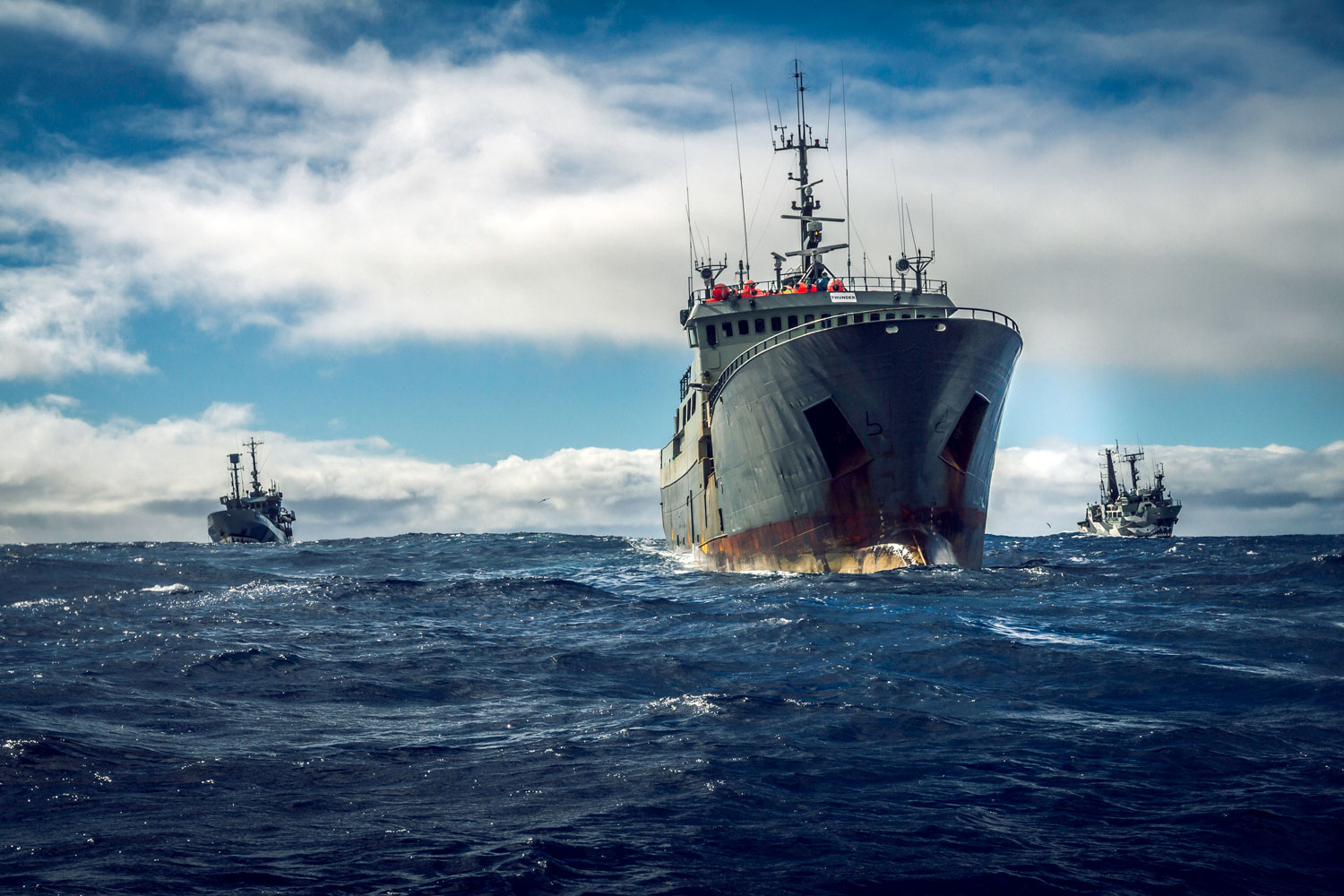It’s hard to think of a more dramatic plot: A 110 day chase, a 10,000-mile pursuit across three oceans. A poaching “kingpin” who dredges the ocean for tons of sealife. A heroic crew of marine activists that brings this super-villain to justice.

Many environmental documentaries tend to be cerebral, fact-crammed chronicles, but co-directors’ Marc Levin and Mark Benjamin’s 96-minute Chasing the Thunder has as much in common with a Hitchcock thriller or action hero blockbuster as it does with, say, the climate documentary An Inconvenient Truth.
The opening scenes of the award-winning film unfold in the spectacular scenery of Antarctica. The MY Bob Barker — one of several ships operated by the marine conservation group Sea Shepherd Conservation Society —is seen encountering the Thunder, designated by Interpol as one of the most-wanted poach ships, in frigid Antarctic waters. The fishing vessel has been illegally using gillnets to capture tons of Patagonian toothfish. (Toothfish are coveted by poachers because they are sold as Chilean bass in restaurants throughout the northern hemisphere and fetch a high price. ) Barker’s intrepid young captain, Peter Hammarstedt, orders the Thunder’s crew to surrender their ship.
Instead, the poachers burn the incriminating gillnets before fleeing the scene of the nautical crime. In a frantic attempt to elude capture the Thunder deliberately places its dogged, determined pursuers in harm’s way by sailing through dangerous ice floes and stormy weather. At one point the trawler nearly rams the Barker.
Undaunted, for almost four months the Barker remains hot on the Thunder’s trail, chasing the ship from Antarctica to the Indian and Atlantic Oceans. Along the way, the Barker has allies. It’s often accompanied by another Sea Shepherd craft, its sister ship the MV Sam Simon, skippered by “Captain Sid,” aka Siddharth Chakravarty. In a rare case of activist-law enforcement cooperation, the Barker crew also coordinates with INTERPOL, the France-based International Criminal Police Organization.
Sitting next to the tall, laconic, Hammarstedt at an October Chasing the Thunder screening at the Downtown L.A. Film Festival, I whispered, “It’s like the Barker is attempting to make a citizen’s arrest on the high seas.” To which the captain nodded his head and replied: “Exactly.”
Nevertheless, over the years Sea Shepherd’s daring, direct action tactics to protect sea life have often landed it in hot legal water. The nine vessel Sea Shepherd eco-navy was founded in 1997 after Greenpeace expelled firebrand activist Paul Watson for launching direct actions deemed to be too confrontational. (Watson occasionally appears onscreen in Chasing the Thunder, although he isn’t personally aboard either Sea Shepherd vessel during the epic hunt.)
The Barker’s Ahab-like obsession with the Thunder, which leads to the longest pursuit of an illegal fishing vessel in recorded history,
culminates in an unexpected grand finale. I won’t spoil the ending, but let’s just say that the Barker finally catches up with the Thunder at São Tomé and Príncipe, an island nation in the Gulf of Guinea.
And when the poaching crew is forced to board the Barker, the conservationists have to take defensive measures to secure their ship, lest the prisoners stage a mutiny and seize the vessel that has been tracking them for almost four months.
The surrender is followed by a legal case against the Thunder captain and two senior crew members, who are ultimately found guilty on a slew of illegal-fishing-related charges by a São Tomé and Príncipe court and fined more than $17 million. The real life drama’s denouement is briefly depicted onscreen at the end of the film. As TakePart puts it, the verdict was “a huge victory for Sea Shepherd in the fight against illegal, unreported, and unregulated fishing, an industry that costs more than $20 billion annually in lost catch, fishing jobs, and depletions of fish stocks worldwide.” This collaboration between independent activists, law enforcement and the courts — who often find themselves on opposite sides of environmental issues — in rendering justice on an international scale is particularly noteworthy. It could serve as a roadmap for future eco-cooperation for conservation measures. Call it “direct action” meets “the long arm of the law.”.”
Chasing the Thunder, which is a recut version of the six-part television series “Ocean Warriors” that ran on Animal Planet, offers a sit-on-the-edge-of-your-seat experience for viewers.
I found this stand-up-and-cheer documentary to be extraordinarily inspiring, especially considering the dark days we live in, at sea and back on land. The nonfiction film’s sumptuous cinematography, from Antarctica to Africa, is at times eye-popping and helps to keep one’s attention. (Co-director Mark Benjamin is credited as the cameraman.) The daring of this death defying crew of men and women dedicated to a noble cause is admirable and breathtaking.
Guerrilla fighter Che Guevara once said: “Many will call me an adventurer, and that I am … only one of a different sort: one who risks his skin to prove his truths.” The same seems true for Sea Shepherd’s fearless eco-adventurers.
We don’t have a paywall because, as a nonprofit publication, our mission is to inform, educate and inspire action to protect our living world. Which is why we rely on readers like you for support. If you believe in the work we do, please consider making a tax-deductible year-end donation to our Green Journalism Fund.
Donate